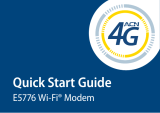
CONTENTS
EtherLINQ User’s Guide iii
7.1 LTE Setup ............................................................................................................................................... 27
7.2 LTE Keep-Alive ....................................................................................................................................... 27
CHAPTER 8: WAN TAB ...................................................................................................................................... 29
8.1 WAN Setup ............................................................................................................................................. 29
8.2 WAN Fail-Over ....................................................................................................................................... 30
8.3 WAN Keep-Alive ..................................................................................................................................... 30
CHAPTER 9: WIFI TAB ....................................................................................................................................... 32
CHAPTER 10: VPN TAB ................................................................................................................................... 34
10.1 IPSec VPN Settings ............................................................................................................................... 35
10.2 Add an IPSec Net-to-Net Rule ............................................................................................................... 36
10.3 Add an IPSec Remote User Rule ........................................................................................................... 39
10.4 IPSec Tunnel Status ............................................................................................................................... 42
CHAPTER 11: GPS TAB ................................................................................................................................... 44
11.1 GPS Setup ............................................................................................................................................. 44
11.2 GPS Data Streams ................................................................................................................................. 45
CHAPTER 12: USB TAB ................................................................................................................................... 46
12.1 USB Webcam Setup .............................................................................................................................. 46
12.2 USB Serial Device Server Setup ............................................................................................................ 49
CHAPTER 13: ADVANCED TAB ...................................................................................................................... 50
13.1 Device Access ........................................................................................................................................ 50
13.2 Scheduled Reboot .................................................................................................................................. 51
13.3 Dynamic DNS (DDNS) ........................................................................................................................... 52
13.4 Syslog Server ......................................................................................................................................... 53
13.5 Additional Configuration ......................................................................................................................... 54
CHAPTER 14: ADMIN TAB .............................................................................................................................. 55
14.1 Device Maintenance ............................................................................................................................... 55
14.2 Configuration Settings ............................................................................................................................ 57
14.3 Tools ....................................................................................................................................................... 58
14.4 Debug Information .................................................................................................................................. 59
CHAPTER 15: LOG TAB .................................................................................................................................. 60
CHAPTER 16: CONFIGURATION MODE ........................................................................................................ 61
APPENDIX .............................................................................................................................................................. 62






















